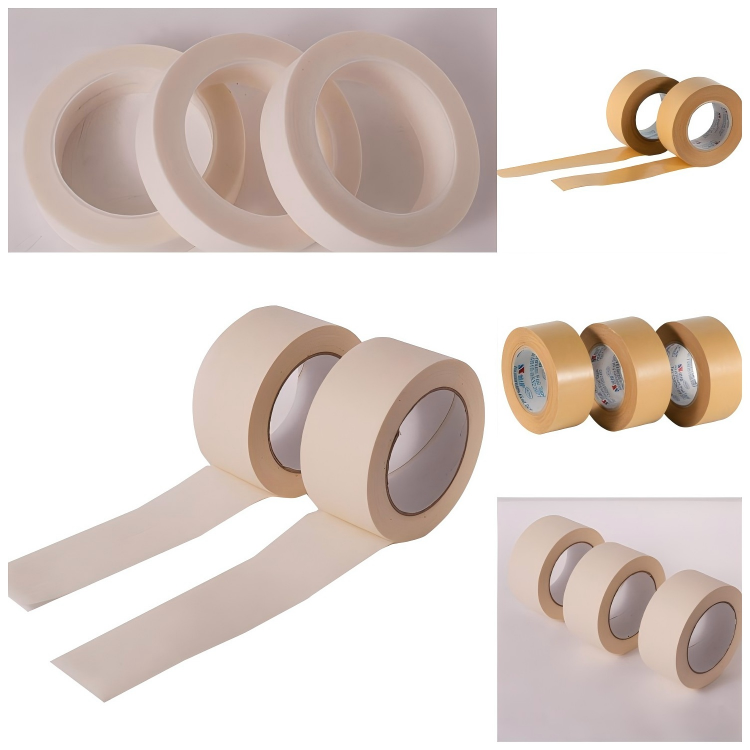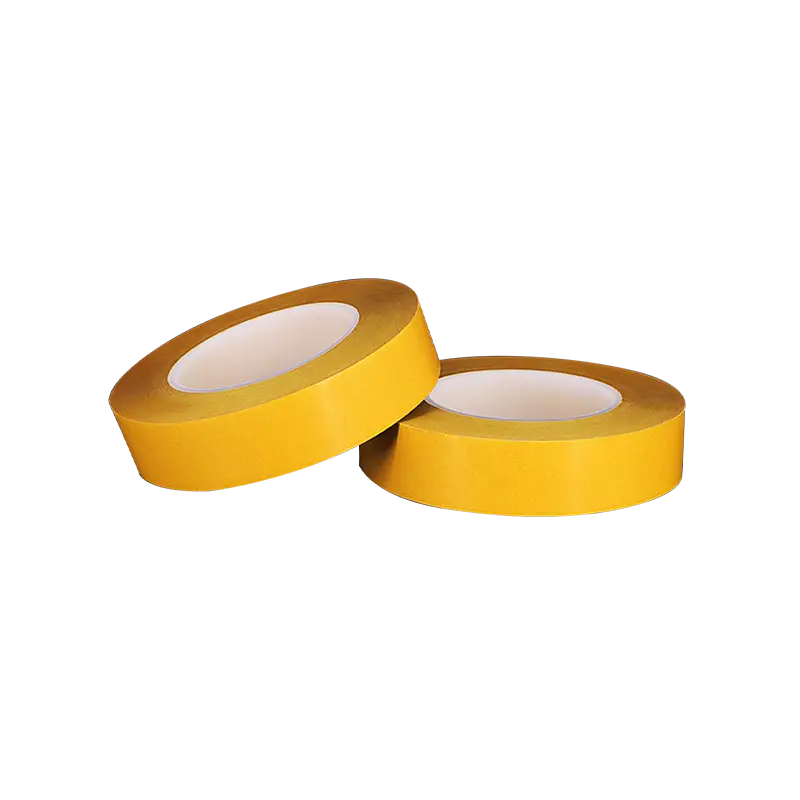In an era where environmental sustainability has shifted from a niche concern to a global imperative, paper tape has quietly emerged as a transformative adhesive solution that marries functionality with eco-consciousness. For decades overshadowed by plastic-based alternatives—such as BOPP (biaxially oriented polypropylene) tapes, PVC tapes, and duct tapes—paper tape is redefining expectations with its unique blend of versatility and green credentials.
At its core, paper tape consists of a paper backing—ranging from ultra-thin crepe paper (for delicate tasks) to thick, reinforced kraft paper (for heavy-duty sealing)—coated with adhesives tailored to specific uses. These adhesives include water-activated starch (a classic, eco-friendly choice), pressure-sensitive rubber (for instant bonding), or acrylic (for enhanced durability). This simple yet adaptable structure allows paper tape to excel in scenarios as diverse as industrial shipping, artisanal packaging, home repairs, and creative crafts.
Today, the paper tape family has expanded to include specialized variants like paper packing tape (for carton sealing), kraft paper tape (known for strength), ventilation tape (breathable for HVAC systems), and double-sided tape (paper-backed for discreet bonding). Together, these products form a comprehensive toolkit that addresses modern demands for sustainability without compromising on performance.

The rise of paper tape is no accident—it aligns with a global movement to reduce plastic waste, which currently clogs landfills, pollutes oceans, and contributes significantly to carbon emissions. Unlike plastic tapes, which can take centuries to decompose, paper tape is inherently biodegradable and fully recyclable, often integrating seamlessly into paper recycling streams (no need for tedious separation from cardboard boxes).
Beyond its environmental benefits, paper tape offers practical advantages that appeal to industries and consumers alike:
· Hand-tearable convenience: Eliminates the need for scissors or dispensers, a boon for quick packaging or on-the-go repairs.
· Clean removal: Many variants, such as painter’s tape, peel off without leaving sticky residue, making them ideal for temporary applications.
· Printability: Its paper surface accepts ink, paint, and labels easily, enabling branding, customization, or labeling—critical for e-commerce, retail, and organizational tasks.
· Adaptability: From lightweight crafts to heavy-duty shipping, there’s a paper tape variant designed to meet specific strength, adhesion, and environmental needs.
As businesses and consumers increasingly prioritize sustainability, demand for eco-friendly alternatives has surged—driving innovation among moisture-proof paper adhesive tapes manufacturers and other industry players to enhance paper tape’s performance, durability, and versatility.
Crafted with a crepe paper backing and coated with rubber or acrylic adhesives, masking tape is prized for its temporary hold and clean removal. It’s a staple in painting and home improvement, where it protects surfaces from paint splatters. Painter’s tape, a premium subset, offers enhanced precision—its adhesive is engineered to peel cleanly even after days (or weeks) of exposure to paint, moisture, or mild UV light, making it ideal for detailed projects like accent walls or furniture refinishing.
Originating from Japan, washi tape is made from traditional Japanese paper (often from bamboo, hemp, or mulberry fibers) with a low-tack adhesive. Its lightweight, flexible, and reusable nature, combined with vibrant patterns and colors, has made it a favorite in crafts, journaling, scrapbooking, and gift wrapping. Unlike plastic decorative tapes, washi tape is biodegradable, appealing to eco-conscious crafters.
Kraft paper tape is the workhorse of the paper tape family, featuring a thick, sturdy kraft paper backing (derived from unbleached wood pulp) that provides exceptional tensile strength. When paired with water-activated starch adhesive (known as gummed tape), it forms an unbreakable bond with cardboard, as the adhesive seeps into the paper fibers—creating a seal that’s resistant to tampering, moisture, and temperature fluctuations. This makes it a top choice for industrial shipping, heavy cargo, and eco-friendly e-commerce packaging.
· Ventilation tape: Designed with a porous paper backing, this tape allows air circulation, making it ideal for sealing joints in HVAC systems, ductwork, or insulation where moisture buildup must be avoided.
· Double-sided tape: Features adhesive on both sides of a thin paper backing, enabling discreet bonding for tasks like mounting photos, securing art projects, or attaching lightweight materials without visible tape edges.
· Moisture-proof paper tape: Developed by moisture-proof paper adhesive tapes manufacturers, these variants use water-resistant adhesives (often acrylic-based) and treated paper to withstand humid environments, cold storage, or outdoor use—bridging a historic gap in paper tape’s performance.
· Renewable sourcing: Most paper tapes are made from wood pulp, a renewable resource (especially when sourced from FSC-certified, sustainably managed forests).
· Closed-loop recyclability: Unlike plastic tapes, which contaminate paper recycling streams, paper tape can be recycled alongside cardboard, reducing waste and processing costs.
· Biodegradability: Even if discarded improperly, paper tape breaks down naturally, minimizing long-term environmental harm.
· Lower carbon footprint: Producing paper tape requires less energy than manufacturing plastic tapes, which rely on fossil fuels.
· Versatile adhesion: From smooth cardboard to textured surfaces like fabric or wood, paper tape adapts to diverse materials.
· Customization: Its printable surface allows businesses to add logos, recycling instructions, or branding—enhancing brand identity while promoting sustainability.
· Safety: Free from harmful chemicals like phthalates (found in some plastic tapes), paper tape is safer for food packaging, children’s crafts, and healthcare settings.
· Reduced waste costs: Because paper tape is recyclable, businesses save on waste disposal fees associated with plastic tape.
· Efficiency in automation: Modern water-activated paper tapes integrate seamlessly with automated packaging lines, reducing labor costs and improving throughput.
· Consumer appeal: As eco-conscious shoppers prioritize sustainable packaging, using paper tape can enhance brand reputation and customer loyalty.
|
Feature |
Paper Tape (kraft/gummed) |
Plastic Tape (BOPP/PVC) |
Cloth/Fabric Tape |
|
Recyclability |
High (recycles with cardboard) |
Low (contaminates paper recycling) |
Low (mixed materials) |
|
Tearability |
Excellent (hand-tearable) |
Poor (requires tools) |
Varies (often frays) |
|
Environmental Impact |
Low (biodegradable, renewable) |
High (fossil-based, non-biodegradable) |
Moderate (plastic adhesives) |
|
Sealing Strength |
Excellent (with gummed adhesive) |
Good (but weakens in heat/moisture) |
Moderate (stretchy but less secure) |
|
Customization |
Easy (printable surface) |
Limited (requires special inks) |
Minimal |
Kraft paper tape and paper packing tape are revolutionizing e-commerce and logistics. Their high tensile strength ensures boxes withstand the rigors of shipping, while water-activated gummed variants create a tamper-evident seal—critical for high-value items. For brands aiming to reduce their environmental footprint, paper tape eliminates the need for plastic strapping or excessive packaging, aligning with sustainable shipping practices.
From scrapbooking to DIY home decor, washi tape and masking tape are beloved for their flexibility and aesthetic appeal. Washi tape’s repositionable nature makes it perfect for temporary designs, while masking tape’s ability to hold delicate materials (like tissue paper or fabric) simplifies complex projects. Artists also appreciate that paper-based tapes won’t damage fragile surfaces, such as canvas or vintage paper.
Painter’s tape is indispensable for achieving crisp, clean lines in painting projects. Its specialized adhesive ensures it adheres firmly to walls, trim, or furniture during painting but peels away without chipping paint or leaving residue—even after extended use. This makes it a favorite among professionals and DIY enthusiasts alike.
· Double-sided paper tape is ideal for mounting posters, photos, or documents without unsightly tape edges, keeping offices and classrooms neat.
· In healthcare, hypoallergenic paper tape secures bandages gently, minimizing skin irritation—unlike plastic tapes, which can cause redness or allergic reactions.
· Schools use paper tape for classroom crafts and displays, teaching children about sustainability through everyday supplies.
Ventilation tape plays a key role in maintaining air quality and energy efficiency. Its breathable design prevents moisture buildup in ductwork, reducing the risk of mold growth, while its paper backing integrates with insulation materials for a seamless seal.

· For sealing cardboard boxes: Opt for kraft paper tape (pressure-sensitive for light loads) or gummed paper tape (water-activated for heavy shipments).
· For painting or temporary masking: Choose painter’s tape with a 14–60 day clean removal rating, depending on project duration.
· For crafts or decorative purposes: Washi tape (repositionable) or double-sided tape (discreet bonding) work best.
· For HVAC or moisture-prone areas: Select ventilation tape (breathable) or moisture-proof variants from moisture-proof paper adhesive tapes manufacturers.
· Pressure-sensitive adhesives: Offer instant bonding, ideal for quick, low-stress applications (e.g., wrapping gifts, temporary fixes).
· Water-activated starch adhesives: Create a permanent, fiber-bonding seal, perfect for heavy-duty packaging or tamper-resistant sealing.
· Acrylic adhesives: Provide enhanced moisture resistance and durability, making them suitable for outdoor or humid environments.
Look for tapes made from recycled paper content, FSC-certified materials, or compostable adhesives. Many moisture-proof paper adhesive tapes manufacturers now offer these sustainable options, proving that durability and eco-friendliness can coexist.
|
Tape Type |
Strength |
Clean Removal |
Eco-Friendly Features |
Typical Uses |
|
Masking Tape |
Light |
Yes (short-term) |
Biodegradable, low-VOC adhesive |
Painting, labeling, temporary holds |
|
Kraft Paper Tape |
High |
Moderate |
Recyclable, renewable materials |
Box sealing, bundling, general repairs |
|
Gummed Paper Tape |
Very High |
Permanent |
Integrates with cardboard recycling |
Heavy shipments, tamper-evident packaging |
|
Washi Tape |
Low-Medium |
Yes (repositionable) |
Biodegradable, plant-based fibers |
Crafts, journaling, decorative wrapping |
|
Double-Side Tape |
Medium |
Varies (adhesive-dependent) |
Recyclable paper backing |
Mounting, art projects, discreet bonding |
The paper tape market is evolving rapidly, driven by innovation and growing demand for sustainability:
· No-liner water-activated tapes: These streamline automated packaging lines by eliminating waste from plastic liners, reducing costs and environmental impact.
· Moisture-proof advancements: Moisture-proof paper adhesive tapes manufacturers are developing water-resistant formulas using plant-based waxes or bio-based acrylics, expanding paper tape’s use in cold storage, marine shipping, and outdoor applications.
· Recycled-content blends: Tapes made from 100% post-consumer recycled paper are gaining traction, further lowering carbon footprints.
· Smart branding: Custom-printed paper tapes with QR codes, sustainability messages, or unboxing instructions are becoming a marketing tool for eco-conscious brands.
· Tamper-proof integration: Gummed paper tapes embedded with security features (e.g., UV-reactive inks or void labels) are replacing plastic tamper-evident tapes in high-end retail and pharmaceutical packaging.
These trends reflect a broader shift: paper tape is no longer seen as a “compromise” for sustainability but as a high-performance alternative to plastic.
To maximize the effectiveness of paper tape, follow these guidelines:
· Surface preparation: Ensure surfaces are clean, dry, and free of dust or oil—this enhances adhesion, especially for pressure-sensitive variants.
· Water activation for gummed tape: Use a spray bottle or dispenser to apply even moisture; avoid over-saturating, which can weaken the paper backing.
· Storage: Keep paper tape in a cool, dry place. Humidity can cause gummed tape to activate prematurely, while extreme heat may degrade adhesives.
· Application temperature: Apply paper tape in temperatures between 10°C and 30°C (50°F–86°F) for optimal bonding. For cold environments, choose cold-adapted adhesives.
· Removal timing: For painter’s tape, remove it while paint is slightly tacky (not fully dry) to prevent peeling; follow manufacturer guidelines for maximum wear time.
In a world grappling with plastic pollution and climate change, paper tape stands out as a solution that doesn’t force a trade-off between sustainability and performance. From heavy-duty kraft paper tape securing shipping containers to decorative washi tape adding flair to crafts, from moisture-resistant variants protecting goods in transit to double-sided tape enabling seamless mounting—paper tape adapts to modern needs while honoring environmental values.
As moisture-proof paper adhesive tapes manufacturers and innovators continue to push boundaries, paper tape’s capabilities will only expand. For businesses seeking to align with eco-friendly goals, enhance brand reputation, and meet consumer demand for sustainable products, paper tape isn’t just a trend—it’s the future of adhesives.
Would you like help selecting the best paper tape for your specific packaging or creative needs,contact us for customized solutions and free samples.